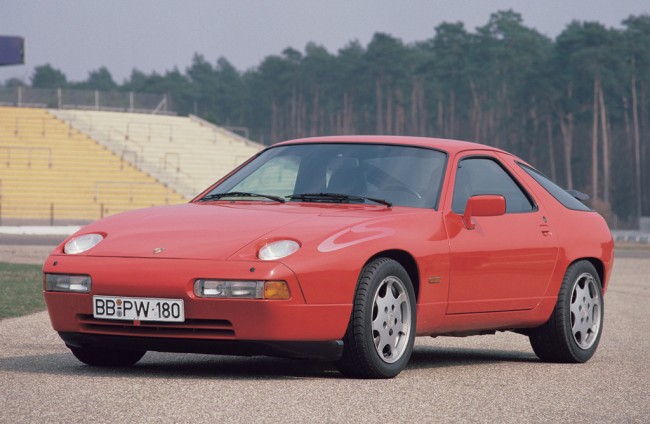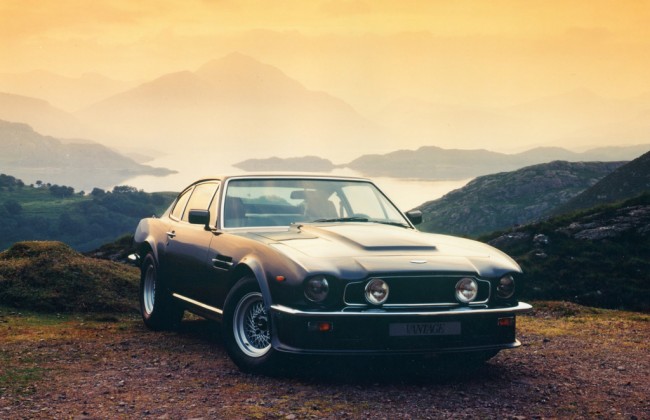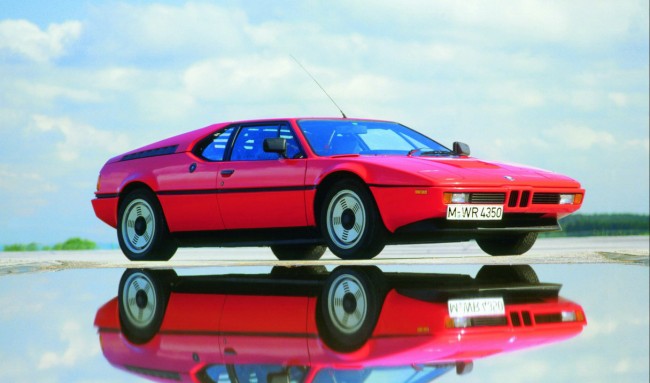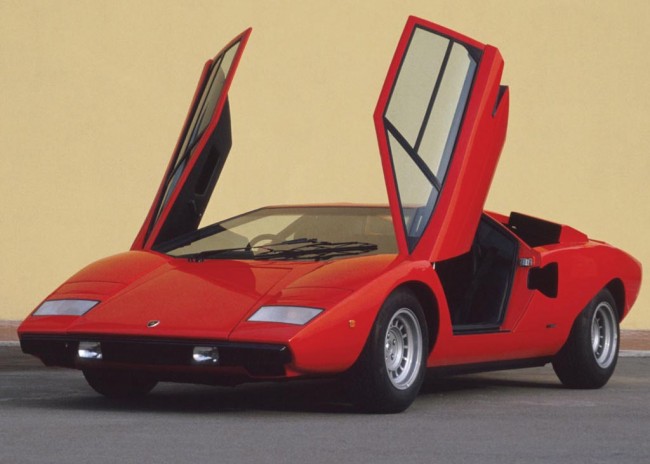 This post is a followup to our Top 7 supercars from the 1960s.
This post is a followup to our Top 7 supercars from the 1960s.
70s was not easy for the auto industry: oil crisis, new car emissions standards and first road speed limitations(55 mph in US) were not helpful for the development of supercars.
Thankfully there were people who did not stop and kept developing high performance cars with passion.
Some of the most remarkable cars from that era are a Ferrari 365 GT4 BB and Lamborghini Countach LP400, which was produced until 1989.
10. Porsche 928
 Front-mounted water-cooled 4.5-liter V8 engine develops 240 horsepower. Top speed: 138 mph (222.1 km/h), 0-60 mph (0-96 km/h) in 7.0-seconds. Weight: 1,547 kg (3,411 lbs)
Front-mounted water-cooled 4.5-liter V8 engine develops 240 horsepower. Top speed: 138 mph (222.1 km/h), 0-60 mph (0-96 km/h) in 7.0-seconds. Weight: 1,547 kg (3,411 lbs)
At first 928 was suppose to be a replacement for the 911, but later was decided that it will be sold side by side with the 911.
Between 1978-1995 61,067 units were built. Over the year’s overall design did not change much, but engines got more powerful and by 1992 Porsche 928 GTS used already a 5.4-liter V8 that produced 345 horsepower.
In 1978 it was voted European Car of the Year and until today it is the only sports car to have won this competition. Base price was $26 000.
9. Chevrolet Corvette C3 ZR1
 Front-mounted small block 5.7-liter LT1 V8 engine develops 370 horsepower. Top speed: 144 mph (232 km/h), 0-60 mph (0-96 km/h) in 5.7 seconds.
Front-mounted small block 5.7-liter LT1 V8 engine develops 370 horsepower. Top speed: 144 mph (232 km/h), 0-60 mph (0-96 km/h) in 5.7 seconds.
Chevrolet Corvette C3 was produced between 1968 and 1982. One of the rarest and most powerful versions was the ZR1. Total of 53 units were produced between 1970-1972.
ZR1 was street legal, but missed many comfort features like radio, power steering, power windows and air conditioning. ZR1 was equipped witg M-22 special heavy duty transmission, heavy duty J-56 brakes, T.I. ignition, special aluminum radiator, special springs, shocks, and front and rear stabilizer bars. It was meant for people who wanted to race their vehicles.
There was also a ZR2 version, basically it was the ZR1 with a 7.4-liter big block V8 that produced 425 horsepower. Only 12 cars were built.
8. Lancia Stratos HF
 Mid-mounted 2.4-liter Dino Ferrari V6 engine develops 190 horsepower. Top speed 143 mph (230 km/h), 0-60 mph (0-96km/h) 6.4 seconds. Weight: 880 kg (1940.1 lbs)
Mid-mounted 2.4-liter Dino Ferrari V6 engine develops 190 horsepower. Top speed 143 mph (230 km/h), 0-60 mph (0-96km/h) 6.4 seconds. Weight: 880 kg (1940.1 lbs)
Stratos is the car that started a new era in rallying as it was the first car designed from scratch with one goal – racing. Stratos HF was wedge-shaped and at that time unusually short and wide, providing better traction compared to street cars, which were modified for racing.
To compete in Group 5 Lancia had to produce 400 street cars for homologation. Between 1972-1974 492 cars were produced.
Street cars had 190 horsepower, but racing cars were tuned up to 280 horsepower. Two cars were also participating in Group 5 racing with a single turbocharged engine that produced 560 horsepower.
It surely was not the most powerful car, but it was very light thanks to fiberglass body and with excellent handling it dominated the racing tracks. Stratos scored 17 world championship victories and over 50 European championship victories.
7. Maserati Bora

4.9-liter V8 develops 330 horsepower.
Top speed: 165 mph (266 km/h), 0-60 mph (0-96 km/h) in 6.5 seconds.
Weight: 1520 kg (3,351 lbs)
Bora stands at just 1183 mm high and features brushed stainless steel roof and windscreen pillars. It was the first production car in the world to use high pressure hydraulics to move the pedal box.
First Boras used a 4.7-liter engine, which soon after was replaced with a similar 4.9-liter unit.
Between 1971 and 1978, 524 Boras were built, 289 had a 4.7-liter V8 and 235 had a 4.9-liter V8.
6. DeTomaso Pantera
 Mid-mounted 5.8-liter V8 engine develops 330 horsepower. Top speed: 174 mph (280 km/h), 0-60 mph (0-96 km/h) in 5.5 seconds. Weight: 1,417 kg (3123 lbs)
Mid-mounted 5.8-liter V8 engine develops 330 horsepower. Top speed: 174 mph (280 km/h), 0-60 mph (0-96 km/h) in 5.5 seconds. Weight: 1,417 kg (3123 lbs)
Argentinian racing driver Alejandro De Tomaso combined Italian engineering and American power and the result was Pantera.
The car was suppose to offer Lamborghini like performance for a lot less money. In 1971 Pantera sold for around $10,000. At the time it was considered almost as exotic as Ferrari or Lamborghini, its low price was possible thanks to the cheap and potent Ford engine.
Problem with Pantera was its build quality. Elvis Presley once got so angry that he shot his Pantera because the car would not start.
Later on several modifications were done to the car, but quality was the problem until 1991 when the production finally ended. During that time 7260 Pantera’s were built out of which around 1,500 still exist.
5. Porsche 911 Carrera RS 2.7
 Rear mounted 2.7-liter B6 develops 207 horsepower. Top speed: 150 mph (241 km/h), 0-60 mph (0-96 km/h) in 5.7-seconds. Weight: 1,095 kg / 2,414 lbs
Rear mounted 2.7-liter B6 develops 207 horsepower. Top speed: 150 mph (241 km/h), 0-60 mph (0-96 km/h) in 5.7-seconds. Weight: 1,095 kg / 2,414 lbs
911 Carrera RS 2.7 is considered by many Porschephiles the greates classic 911. RS version was built so that Porsche could enter new European GT Championship. Rules demanded that a certain number of production cars were also made.
Carrera 2.7 RS had a larger engine(2.7-liter) compared to the standard 911. In total 1580 cars were made between 1972-1973. Also 49 Carrera RS models were built with 2.8-liter engines that produced close to 300 horsepower.
4. Aston Martin V8 Vantage

Front-mounted 5.3-liter V8 develops 390 horsepower.
Top speed: 170 mph (274 km/h), 0-60 mph (0-96 km/h) in 5.3 seconds. Weight: 1,815 kg (4,001 lbs).
When introduced in 1977 it was hailed as the “Britain’s First Supercar” for its performance numbers.
The Vantage name had previously been applied to a number of high-performance versions of Aston Martin cars, but this was a new model line.
The car was based on the Aston Martin V8, but unique details like 5.3-liter V8, twin driving lights, closed-off hood bulge, blanked off grille, deep front air dam and a boot lid spoiler at the rear added up to a unique driving experience.
Between 1977-1989 534 units were built out of which 342 were coupes and 192 convertibles.
3. BMW M1
 Mid-engined 3.5-liter 6-cylinder engine develops 273 horsepower. Top speed: 162 mph (260 km/h), 0-60 mph (0-96 km/h) in 5.5 seconds. Weight: 1,300 kg (2,866 lbs).
Mid-engined 3.5-liter 6-cylinder engine develops 273 horsepower. Top speed: 162 mph (260 km/h), 0-60 mph (0-96 km/h) in 5.5 seconds. Weight: 1,300 kg (2,866 lbs).
In 1976, BMW’s Motorsport department started the M1 project because BMW wanted to take part of the Group 5, the highest category GT car racing at the time. The regulations of Group 5 required to build at least 400 cars for homologation.
Between 1978 and 1981, 456(out of which 400 were road cars) M1’s were manufactured. At the time BMW did not have facilities nor expertise for low volume production, so they subcontracted the assembly work to Lamborghini in Italy. M1 was designed by Giorgetto Giugiaro who gave M1 a memorable shape with low stance and wedge profile.
As Lamborghini was in financial trouble, BMW had to reorganize the production with the help of Marchesi, Italdesign and coach builder Baur.
It was the company’s first M-car and so far the only M-car not derived from existing mass production models. In racing trim turbocharged versions produced around 850 horsepower.
2. Lamborghini Countach LP400
Mid-mounted 4-liter V12 engine produced 375 horsepower. Top speed: 180 mph (290 km/h), 0-60 mph (0-96 km/h) in 5.6 seconds. Weight: 1,065 kg (2,347 lbs).
This wedge-shaped, sharply angled and very low supercar was in production between 1974 to 1989. A total of 2042 units were produced. Its body was almost entirely made of flat trapezoidal aluminum panels giving it a very sharp look.
Countach is the car that made “scissor” type doors popular. These doors were for styling reasons and also because the width of car made hard to use conventional doors.
LP400(1974-1978)used a 4.0-liter V12, later on a 5.0 and 5.2-liter V12 engines were introduced with more power. Also from 1978 changes were made to the exterior(like fiberglass wheel arch extensions), tires were replaced with much wider Pirelli P7 units, and optional V-shaped spoiler was added to the rear deck. In 1976 Countach PL400 was priced at around $72,200.
During 70s and 80s it was the dream car for boys and men around the world, Countach posters were decorating thousands of walls, including my bedroom wall when I was just a little boy.
1. Ferrari 365 GT4 BB
 Mid-mounted 4.4-liter flat-12 produced 360 horsepower.
Mid-mounted 4.4-liter flat-12 produced 360 horsepower.
Top speed: 188 mph (302 km/h), 0-60 mph (0-96 km/h) 5.4 seconds. Weight: 1,235 kg (2,722 lbs).
This car was designed as an answer to Lamborghini Miura. Between 1973-1976 387 units were built. Design was done by Pininfarina and the body was an angular wedge with popup headlights.
As the engine’s height was relatively low it allowed the gearbox to be mounted under it, saving a lot of space. This gave it a weight balance of 40:60 and not the best handling. For normal road use the car handled very well, but racing versions were never very successful.
[poll id=”3″]




3 comments
Lets face it. Countach is just FUGLY! I know I also had the poster on my wall, but looking at the car now it is just not right compared to 365 GT4 BB.
I love the Carrera RS 2.7, that’s how the 911 should be. Very light!
I love the Aston Martin. Its got that muscle look to it with that mustang style front kinda like a 77′ Mustang 2 King Cobra with some 66 or 67 styling. Aslo luv the Pantera!